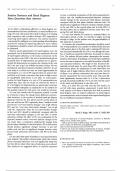Exam (elaborations)
Positive Deviance and Hand Hygiene: More Questions than Answers
- Course
- Institution
To the Editor—Optimizing adherence to hand hygiene rec ommendations has been problematic in many healthcare set tings. We read with interest the article by Marra et al1 relating their experience with a positive deviance (PD) approach to improving hand hygiene adherence. The authors should b...
[Show more]



